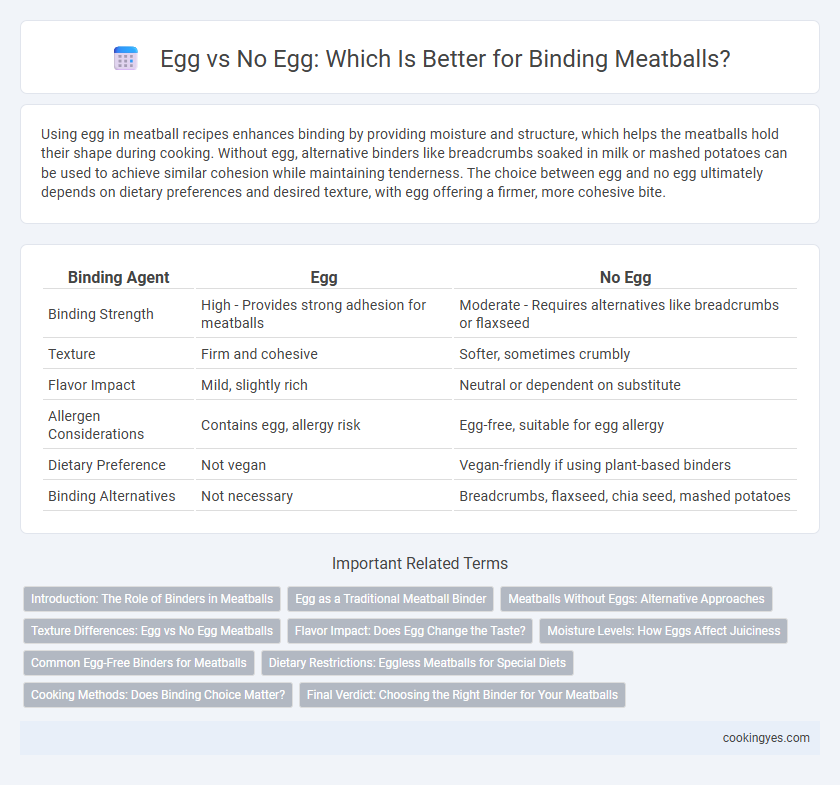Using egg in meatball recipes enhances binding by providing moisture and structure, which helps the meatballs hold their shape during cooking. Without egg, alternative binders like breadcrumbs soaked in milk or mashed potatoes can be used to achieve similar cohesion while maintaining tenderness. The choice between egg and no egg ultimately depends on dietary preferences and desired texture, with egg offering a firmer, more cohesive bite.
Table of Comparison
| Binding Agent | Egg | No Egg |
|---|---|---|
| Binding Strength | High - Provides strong adhesion for meatballs | Moderate - Requires alternatives like breadcrumbs or flaxseed |
| Texture | Firm and cohesive | Softer, sometimes crumbly |
| Flavor Impact | Mild, slightly rich | Neutral or dependent on substitute |
| Allergen Considerations | Contains egg, allergy risk | Egg-free, suitable for egg allergy |
| Dietary Preference | Not vegan | Vegan-friendly if using plant-based binders |
| Binding Alternatives | Not necessary | Breadcrumbs, flaxseed, chia seed, mashed potatoes |
Introduction: The Role of Binders in Meatballs
Binders like eggs play a crucial role in meatball preparation by enhancing texture and preventing crumbling during cooking. Eggs provide moisture and act as a protein matrix, improving cohesion among ground meat, breadcrumbs, and seasonings. Alternatives without eggs rely on ingredients such as breadcrumbs, grated vegetables, or soaked oats to achieve comparable binding and maintain meatball integrity.
Egg as a Traditional Meatball Binder
Egg serves as a traditional meatball binder by providing essential proteins that coagulate during cooking, ensuring the meat mixture holds together firmly. Its natural emulsifying properties create a tender, moist texture while preventing crumbly meatballs. Using egg as a binding agent also enhances flavor and helps distribute seasoning evenly throughout the mixture.
Meatballs Without Eggs: Alternative Approaches
Meatballs without eggs rely on alternative binding agents such as breadcrumbs soaked in milk, mashed potatoes, or ricotta cheese to maintain their shape and moisture. These substitutes effectively trap juices during cooking, preventing the meatballs from falling apart while enhancing tenderness. Using flaxseed meal mixed with water also provides a plant-based binding option that mimics egg's adhesive properties in meatball recipes.
Texture Differences: Egg vs No Egg Meatballs
Eggs act as a natural binder in meatballs, creating a firmer, more cohesive texture by holding the ingredients tightly together during cooking. Without eggs, meatballs often have a looser, crumbly texture, which can result in a softer bite but may require additional binding agents like breadcrumbs or mashed vegetables to maintain shape. The choice to use eggs significantly influences the moisture retention and tenderness, with egg-based meatballs typically offering a denser, more uniform texture compared to the lighter, more delicate texture of egg-free variations.
Flavor Impact: Does Egg Change the Taste?
Egg significantly enhances the flavor profile of meatballs by adding a rich, creamy taste that balances the savory meat. Without egg, meatballs often have a denser texture and a more straightforward, meat-forward flavor. Incorporating egg not only improves binding but also subtly boosts moisture retention, leading to a juicier and more flavorful bite.
Moisture Levels: How Eggs Affect Juiciness
Eggs contribute significantly to meatball moisture by acting as a binding agent that traps water during cooking, resulting in juicier meatballs. Without eggs, meatballs may dry out more easily, as the mixture lacks the protein matrix needed to retain moisture effectively. Using eggs balances texture and juiciness, enhancing the overall mouthfeel and preventing crumbly consistency.
Common Egg-Free Binders for Meatballs
Common egg-free binders for meatballs include breadcrumbs soaked in milk or water, mashed potatoes, and soaked oats, which effectively retain moisture and improve texture. Ground flaxseeds or chia seeds combined with water create a gel-like consistency that mimics egg's binding properties while adding fiber and omega-3 fatty acids. Pureed vegetables such as pumpkin or sweet potato also enhance cohesion and flavor without compromising the meatball's structure.
Dietary Restrictions: Eggless Meatballs for Special Diets
Eggless meatballs provide an ideal protein-rich option for individuals with egg allergies or following vegan and plant-based diets. Using alternatives like flaxseed meal, chia seeds, or mashed vegetables ensures meatballs maintain moisture and binding without animal products. These substitutions cater to gluten-free, kosher, and halal dietary needs, expanding accessibility while preserving texture and flavor.
Cooking Methods: Does Binding Choice Matter?
Egg serves as a natural binder in meatballs, enhancing texture and preventing crumbling during frying, baking, or simmering in sauce. Meatballs without egg rely on alternative binders like breadcrumbs, oatmeal, or mashed vegetables, which can alter moisture retention and firmness depending on the cooking method. The choice of binder significantly impacts the structural integrity and mouthfeel of meatballs, influencing the final outcome in recipes requiring different cooking techniques.
Final Verdict: Choosing the Right Binder for Your Meatballs
Egg serves as an effective binder for meatballs, providing moisture and a firm texture that holds ingredients together during cooking. Without egg, alternatives like breadcrumbs soaked in milk or mashed potatoes can maintain moisture and cohesion, catering to dietary restrictions or preferences. The final verdict depends on desired texture and dietary needs; egg offers traditional firmness while egg-free options ensure a tender, adaptable meatball.
Egg vs No Egg for Meatball Binding Infographic

 cookingyes.com
cookingyes.com